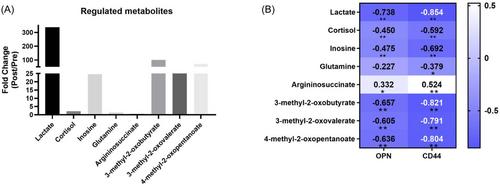The aim of this study was to combine proteomics and metabolomics to evaluate the immune system of short-track speed skaters (STSS) before and after a training course. Our research focused on changes in urinary proteins and metabolites that have the potential to serve as indicators for training load.
Urine samples were collected from 21 elite STSS (13 male and 8 female) of the China National Team before and immediately after one training course. First-beat sports sensor was used to monitor the training load. Proteomic detection was performed using a Thermo UltiMate 3000 ultra high performence chromatography nano liquid chromatograph and an Orbitrap Exploris 480 mass spectrometer. MSstats (R package) was used for the statistical evaluation of significant differences in proteins from the samples. Two filtration criteria (fold change [FC] > 2 and p < 0.05) were used to identify the differential expressed proteins. The Kyoto Encyclopedia of Genes and Genomes enrichment analysis for differential proteins was performed to identify the pathways involved. Nontargeted metabolomic detection was performed using ultra performance liquid chromatography tandem mass spectrometry (UPLC-MS/MS_) with an ACQUITY 2D UPLC plus Q Exactive (QE) hybrid Quadrupole-Orbitrap mass spectrometer. Differential metabolites were identified using non-parametric statistical methods (Wilcox's rank test). Two filtration criteria (FC > 1.2 and p < 0.05) were used to identify differential metabolites. Combined analysis of proteomic and metabolomics were performed on the “Wu Kong” platform. Correlation analysis was performed using Spearman's rank correlation coefficient.
(1) The most upregulated proteins were immune-related proteins, including complement proteins (C9, C4–B, and C9) and immunoglobulins (IgA, IgM, and IgG). The most downregulated proteins were osteopontin (OPN) and CD44 in urine. The correlation analysis showed that the content of OPN and CD44 (the receptor for OPN) in urine were significantly negatively correlated with the upregulated immune-related proteins. The content of OPN and CD44 is sex-dependent and negatively correlated with the training load. (2) The most upregulated metabolites included lactate, cortisol, inosine, glutamine, argininosuccinate (the precursor for arginine synthesis), 3-methyl-2-oxobutyrate (the catabolite of valine), 3-methyl-2-oxovalerate (the catabolite of isoleucine), and 4-methyl-2-oxopentanoate (the catabolite of leucine), which is sex-dependent and negatively correlated with OPN and CD44. (3) The joint analysis revealed five main related pathways, including the immune and innate immune systems. The enriched immune-related proteins included complements, immunoglobulins, and protein catabolism-related proteins. The enriched immune-related metabolites included cAMP, N-acetylgalactosamine, and glutamate. (4) There is a significant negative correlation between the content of OPN and CD44 in urine and the training load.
One training course can lead to the activation of the immune system and a sex-dependent decrease in the content of OPN and CD44. Training load has a significant and negative correlation with the content of OPN and CD44, suggesting that OPN and CD44 could be potential indicators for training load.



